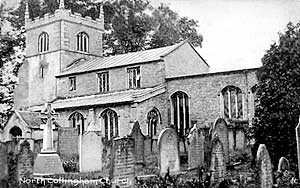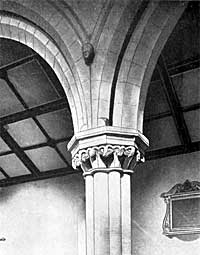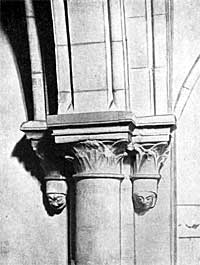
All Saints' church, North Collingham.
South Scarle was the furthest point reached, and the return journey was made by way of Besthorpe, which chapelry, together with that of Girton, goes with the Scarle living.
On arriving at the church of All Saints, North Collingham, the visitors found the vicar, the Rev. F. W. Goodacre, waiting to receive them. The church is approached from the north-west side through a lychgate, and stands on ground considerably higher than the roadway.
It is obvious from the comparatively recent flood-marks on the stones, at the south-west entrance gate, that the original builders were obliged to select an elevated site for the church at its erection some 600 years ago; for doubtless the Trent was then as liable to overflow its banks as it is in these days. One of these marks records the greatest height, i.e., five feet two inches above the present roadway, reached by the enormous flood that occurred in February, 1795, when a long and severe frost broke up so rapidly that the waters of the Trent and the Witham became for a time united ! The stone1 which now bears this record has served at some time as the base of a churchyard or village cross. A fragment of the shaft of the cross is also built into the wall close by.
Another stone in the lower part of the wall records the high water mark reached by the flood of October, 1875, i.e., three feet five inches above the level of the causeway.
Here again are two instances of sundials near the door on the south side of the chancel, on one of which the figures remain very legible.
The registers are interesting; they commence in 1558. From them it seems that this place suffered severely from the plague. The burial of the first victim took place on 11th August, 1646, and there are no less than thirty-two entries of burials of persons who died from this visitation, ranging from the above date to 23rd December in the same year. In several cases the interments seem to have been so speedily carried out that even the names of the deceased are not filled in! There is one entry in 1646 which reads:—"Richard Thornton, labourer, who was killed with the fall of stone at the pulling down of Newark Castle, was buryed the 1st day of July." This assists in fixing the time when the castle was dismantled, after having offered so sturdy a resistance in the cause of King Charles I.
Once more Mr. Blagg kindly read a paper to the visitors as follows.
Mr. T. M. BLAGG'S PAPER.


This church is dedicated to All Saints. At South Collingham and again at South Scarle we saw fine examples of Norman arcades, while here, the Early English period is exemplified by very beautiful examples of that style. One of the earliest pieces in the church, and one of quite exceptional beauty, is the north respond of the tower arch. The centre member of the arch, which is of two orders, with bold roll moulds at the angles, comes down on to a columnar respond, while the outer members on either side fall on to corbels stopped with masks. The capitals of the whole respond have circular neck moulds, and have been most beautifully sculptured with volutes of conventional foliage, now, alas, much broken and defaced. Above, is a square abacus with the characteristic quirk and a cove and bead mould beneath it. The arcades are typically Early English, and were probably both erected at the same time, for though they differ in details, they both alike contain features of the early and of the later periods of that style. I should assign their date as between 1220 and 1250. The arches of both arcades are of two orders, and double chamfered. Their hood-moulds, also both double chamfered, rest, on the south, on boldly carved rosettes, instead of on the customary heads, as on the north. The eastern respond on the north is a shaft with belt-mould or zone, that on the south is a corbel or bracket stopped with a mask and relieved by two lines of nail-head ornament.
The piers are of great beauty. Those on the south are clustered columns of ridge-shafts or bowtels, with fillets alternating, always an effective combination. They have circular capitals with no foliage, but relieved by nailhead ornament. The piers on the northern side, also consisting of clustered shafts, have capitals richly carved with volutes of conventional foliage. All the piers have water-moulds at the base. The chancel arch, which is being depressed and thrust out by the weight of masonry above it, is also Early English with voluted ornamentation on its capitals, somewhat similar to that on the eastern respond of the north arcade. The tower and font complete the list of Early English features. To the next period of architecture may be assigned the north aisle, possibly erected by Godfrid, abbot of Peterborough, about 1316. It contains a piscina with a semi-circular dished drain of seven flutes. The chancel has an east window of a late type, and contains a piscina with circular fluted drain. A double piscina, with dividing shaft, should be noticed below the eastern respond of the south arcade. It was possibly for the use of both a side altar in the south aisle and of another altar in the rood loft. The east window of the south aisle is Perpendicular, with an embattled transome; the remaining windows are for the most part of a late and debased type. Outside the chancel door is incised on the jamb a circular sundial eight inches in diameter, with the numbers of the hours inscribed. At the apex of the tower arch will be noticed the head of a woman wearing a wimple ; it is, of course, an insertion, removed from some other part of the fabric, possibly placed there as a corbel to support the Royal arms of the Georgian period still hung above it. Above the chancel arch will be noticed seven shields of wood. These formerly decorated the under parts of so many miserere seats, now no more. Their carving and heraldry are described in detail in Wake's History of Collingham, p. 29. An iron-bound chest of great length should be noticed in the vestry. The font cover, carved and inlaid, is of the end of the 17th century, though the dentils under its cornices are modern additions. In a long list of dilapidations in this church, presented at the Archdeaconry Court of Nottingham in 1684, it is reported that the "cover for the font is wanting," and the present cover is apparently the one then ordered to be procured.
In the north porch are reared up two large sepulchral slabs with demi-effigies of the 14th century in civilian costume. These were found at the east end of the north aisle during one of the restorations of the church. That against the east wall has his feet resting on a dog, while the large shield which covers his body is charged with three unicorns' heads couped, but the identity of neither figure has been discovered. They appear to be both male figures, that on the west wall with the blank shield differs slightly in costume from the other, having the long lappets, known as "liripipes," depending from the sleeves.
The registers at North Collingham begin, like those of South, in 1558, but I have not had an opportunity of examining them.
The bells are four in number, and are described by Wake as:—
1. Dated 1616, inscribed: "Sweetly toling men do call to taste meate that feeds the soul."
2. Dated 1661, motto "Jesus be our speed."
3. Dated 1715, inscribed "Haec Campana flat sacra Trinitate beata."
4. Dated 1797, inscribed "Charles Lesiter, Wm. M. Dewick, Ch: Wardens. Thomas Osborne, Downham, Norfolk, fecit."
The large stone near the gate in the churchyard wall on which is marked the height of the record flood of 1795, when the Trent and Witham joined, is the pediment of the churchyard cross, with square socket and boldly carved stops at the angles. The fine crocketed shaft of the village cross on the top of its pyramid of steps was doubtless noticed by the members as they passed it on their journey out to Scarle.
The next place to be visited was Mr. Cecil Smith Woolley's house in South Collingham.
It has been known to most local antiquaries that Mr. Woolley has for some time past taken great pains in the investigation of the site of the Roman station of Crocolana at Brough, four miles distant from Newark on the Fosse Road, and twelve from Lincoln.
The guests assembled in Mr. Woolley's garden, where the treasures he has unearthed were displayed on a long table. He proceeded to describe these in a very interesting address, which, to some extent, will be found embodied in a separate paper in the present volume of Transactions.
At the close of Mr. Woolley's address, he very considerately provided tea for the visitors, for which a unanimous vote of thanks was accorded him.
The party then proceeded on the return journey to Newark, visiting the site of Crocolana station on their way there.
Before quitting Collingham it may be well to mention that in Magna Brittania, and possibly in other works, it is stated that in very ancient days, St. Ebba had a convent here, and that she and her nuns disfigured themselves by cutting off their lips and noses through fear of the barbarous Danes. The legend, however, as far as regards Collingham, seems to be without any sufficient foundation, and the paragraph concludes by saying, "The Collingham where the chaste women lived was a town in Scotland and the nunnery was a cell in the Abbey of Durham."
The misconception no doubt arose from a confusion between the names of Collingham and Coldingham in Berwickshire, where there was a monastery with which St. Ebba was associated, and gave her name to St. Abb's Head, near by. The monastery was destroyed by fire A.D. 679, and St. Ebba herself died shortly after, reputedly on 25th May, A.D. 683. Her remains, after some vicissitudes, eventually found a resting place by the side of those of her friend, St. Cuthbert, in his shrine at Durham. Any one who may desire further details can refer to the Dictionary of Christian Biography (Murray, 1880).
The illustrations in connection with the second excursion are from photographs kindly furnished by the following gentlemen, viz., Messrs. E. Guilford, George Harrison, R. F. B. Hodgkinson, — Hoe, and J. Selby.
(1) It is not impossible that this stone may have been moved since 1795, in which case the flood-mark would, of course, be misleading.
